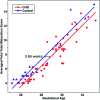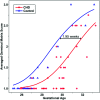Association of Isolated Congenital Heart Disease with Fetal Brain Maturation
- PMID: 32646947
- PMCID: PMC7658885
- DOI: 10.3174/ajnr.A6635
Association of Isolated Congenital Heart Disease with Fetal Brain Maturation
Abstract
Background and purpose: Brain MRI of newborns with congenital heart disease show signs of immaturity relative to healthy controls. Our aim was to determine whether the semiquantitative fetal total maturation score can detect abnormalities in brain maturation in fetuses with congenital heart disease in the second and third trimesters.
Materials and methods: We analyzed data from a prospective study of fetuses with and without congenital heart disease who underwent fetal MR imaging at 25-35 weeks' gestation. Two independent neuroradiologists blinded to the clinical data reviewed and scored all images using the fetal total maturation score. Interrater reliability was evaluated by the intraclass correlation coefficient using the individual reader scores, which were also used to calculate an average score for each subject. Comparisons of the average and individual reader scores between affected and control fetuses and relationships with clinical variables were evaluated using multivariable linear regression.
Results: Data from 69 subjects (48 cardiac, 21 controls) were included. High concordance was observed between readers with an intraclass correlation coefficient of 0.98 (95% CI, 0.97-0.99). The affected group had significantly lower fetal total maturation scores than the control group (β-estimate, -0.9 [95% CI, -1.5 to -0.4], P = .002), adjusting for gestational age and sex. Averaged fetal total maturation, germinal matrix, myelination, and superior temporal sulcus scores were significantly delayed in fetuses with congenital heart disease versus controls (P < .05 for each). The fetal total maturation score was not significantly associated with any cardiac, anatomic, or physiologic variables.
Conclusions: The fetal total maturation score is sensitive to differences in brain maturation between fetuses with isolated congenital heart disease and healthy controls.
© 2020 by American Journal of Neuroradiology.
Figures





References
Publication types
MeSH terms
Grants and funding
LinkOut - more resources
Full Text Sources
Medical
